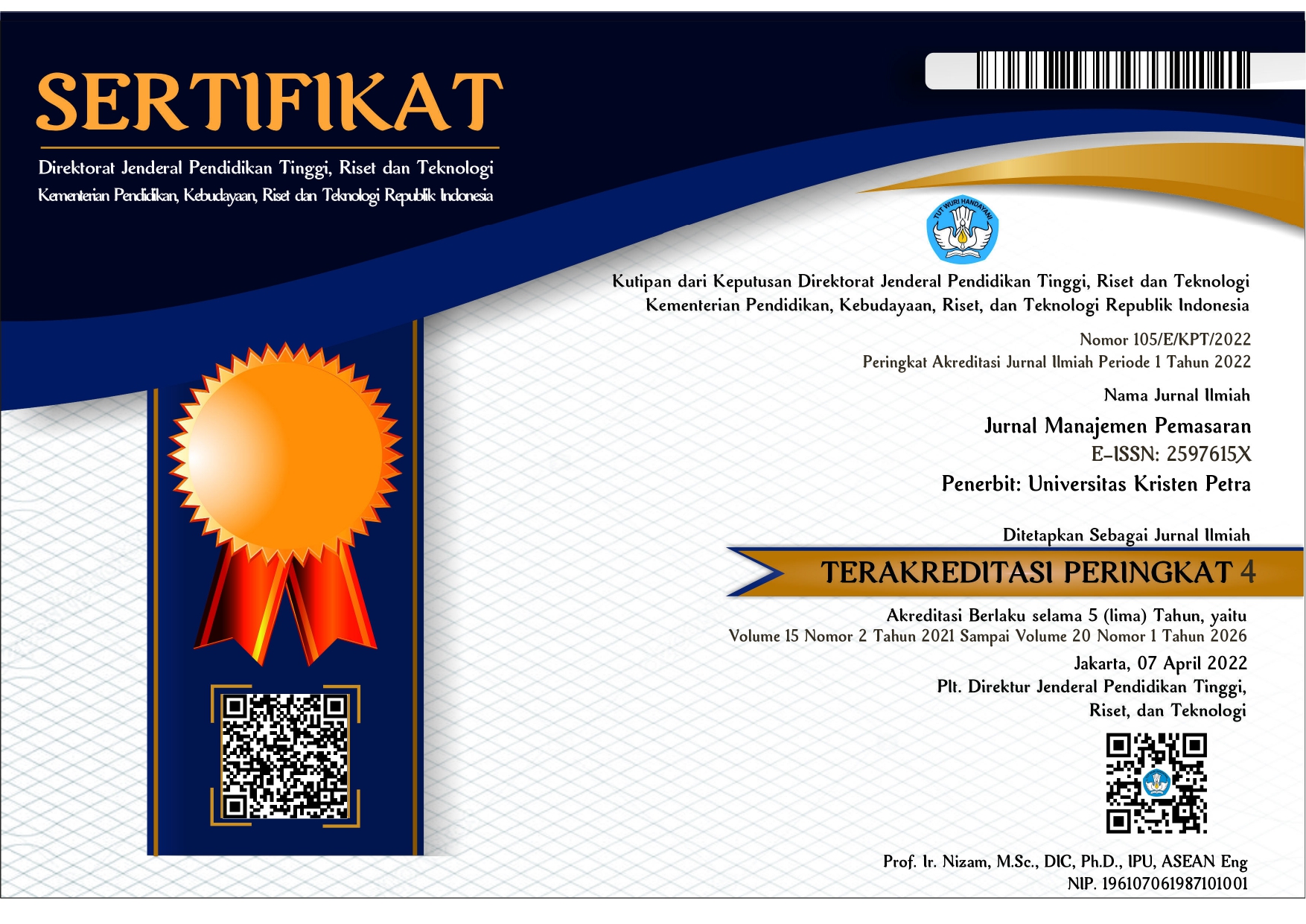FAKTOR-FAKTOR YANG MEMPENGARUHI PASSENGER SATISFACTION DAN PASSENGER LOYALTY PADA LAYANAN TRAVEL DI NUSA TENGGARA TIMUR
 :
:
https://doi.org/10.9744/pemasaran.14.1.8-16
Keywords:
Kualitas layanan, perceived value, perceived usefulness, perceived ease of use, passenger satisfaction, passenger loyaltyAbstract
Penelitian ini bertujuan untuk menjelaskan pengaruh kualitas layanan, perceived value, perceived usefulness, dan perceived ease of use terhadap passenger satisfaction dan passenger loyalty pada layanan travel di Kupang, Nusa Tenggara Timur. Metode penelitian termasuk penelitian kuantitatif dengan jumlah sampel sebanyak 135 penumpang. Data dikumpulkan dengan menggunakan kuesioner, kemudian diolah menggunakan Partial Least Square (PLS). Temuan penelitian menunjukkan bahwa kualitas layanan, perceived value, perceived usefulness, dan perceived ease of use berpengaruh positif terhadap passenger satisfaction, serta passenger satisfaction berpengaruh positif terhadap passenger loyalty.
References
Adams, D.A., Nelson, R. R., & Todd, P. A. (1992). Perceived usefulness, ease of use and usage of information technology: A replication. MIS Quarterly, 16(2), 227-247.
Ajzen, I. (1991). The theory of planned behavior. Organizational Behavior and Human Decision Processes, 50(2), 179-211.
Cronin, J. J., Jr., Brady, M. K., & Hult, G. T. M. (2000). Assessing the effects of quality, value, and customer satisfaction on consumer behavioral intentions in service environments. Journal of Retailing, 76(2), 193-218.
Ghozali, I. (2008). Structural equation modeling: Metode alternatif dengan Partial Least Square. Semarang: Badan Penerbit Universitas Diponegoro.
Greener, S. (2008). Business research methods. London: Ventus Publishing.
Griffin, J. (2005). Customer Loyalty: Menumbuhkan dan Mempertahankan Kesetiaan Pelanggan. Jakarta: Erlangga.
Hapsari, R., Clemes, M.D., & Dean, D. (2017). The impact of service quality, customer engagement and selected marketing constructs on airline passenger loyalty. International Journal of Qua-lity and Service Sciences, 9(1), 21-40,
Hashem, T. N., & Nimer, N. (2019). The impact of service quality on customer loyalty: A study of dental clinics in Jordan. International Journal of Medical and Health Research, 5(1), 65-68.
Hu, K.C., &Jen, W. (2006). Passengers’ perceived service quality of city buses in Taipei: Scale development and measurement. Journal Trans-port Reviews, 26(5), 645-662.
Jen, W., Tu, R. & Lu, T. (2011). Managing passenger behavioral intention: an integrated framework for service quality, satisfaction, perceived value, and switching barriers. Transportation, 38(2), 321-342.
Joewono, T.B., & Kubota, H. (2007). User satisfaction with paratransit in competition with motorization in Indonesia: Anticipation of future implications. Transportation, 34(1), 337-354.
Kotler, P., &Armstrong, G. (2010). Principles of Marketing. New Jersey: Prentice-Hall International.
Lai, W.T., &Chen, C.F. (2011). Behavioral intention of public transit passenger-the role of service quality, perceived value, satisfaction, and involvement. Transport Policy, 18(2), 318-325.
Laucereno, S. F. (2019). Ekonomi Indonesia Timur Tumbuh Lebih Tinggi karena Infrastruktur. Retrieved from https://finance.detik.com/berita-ekonomi-bisnis/d-4416138/ekonomi-indonesia-timur-tumbuh-lebih-tinggi-karena-infrastruktur.
Lemeshow, S., Hosmer, D. W., Klar, J., & Lwanga, S. K. (1990). Adequacy of sample size in health studies. Chichester: John Wiley & Sons.
Lovelock, C. H., & Wright, L. K. (2005). Manajemen pemasaran. Jakarta: Indeks.
Ramayah, T. & Ignatius, J. (2005). Impact of per-ceived usefulness, perceived ease of use and perceived enjoyment on intention to shop online. ICFAI Journal of Management, 3(3), 36-51.
Solomon, M.R. (2012). Consumer Behavior: Buying, Having and Being. London: Prentice-Hall Inter-national.
Sumaedi, S., Bakti, I.G.M.Y., Astrini, N.J., Rakhmawati, T., Widianti, T., &Yarmen, M. (2014). Public Transport Passengers’ Behavioural Intentions: Paratransit in Jabodetabek Indonesia. Singapore: Springer.
Sumaedi, S., Bakti, I.G.M.Y., Astrini, N.J., Rakhmawati, T., Widianti, T. Dan Yarmen, M. (2016). Factors influencing public transport passengers’ satisfaction: a new model. Management of Environmental Quality, 27(5), 585-597.
Tolo, E. Y. S. (2019, February 22). Kesenjangan infrastruktur di timur. Tempo. Retrieved from https://kolom.tempo.co/read/1178263/kesenjangan-infrastruktur-di-timur/full&view=ok
Trisnawati, E., Assegaff, S., & Rohaini, E. (2019). Pengaruh perceived ease of use, perceive usefulness, service quality, perceived value terhadap customer saticfaction pada pengguna grab. Jurnal Ilmiah Mahasiswa Sistem Informasi, 1(2), 82-96.
Wen, C.H., Lan, L.W. dan Cheng, H.L. (2005). Struc-tural equation modelling to determine passenger loyalty toward intercity bus services. Journal of the Transportation Research Board, 19(27): 249-255.
Zeithaml, V. A., Bitner, M.J., & Gremler, D.D. (2008). Services marketing: Integrating customer focuss across the firm. Boston, MA: McGraw-Hill.















